One of the more mainstream criticisms of horse racing is the overall lack of transparency and access. Sure, you can stroll into any racetrack in America, plop down a couple bets and see all the pretty horses dart around the track, you just can’t feel them. You can observe the team of trainers and owners up there in the box seats, you just can’t follow them back to the barn.
The barn. What’s going on back there anyway?
In trainer Maria Borell’s barn, it’s frequent Instagram selfies and the occasional spooning sesh.
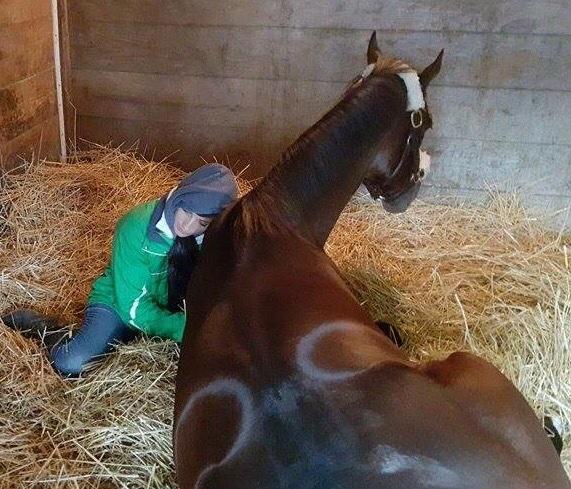
Photo courtesy of Maria Borell (@IMariaValentine)
Sure, there’s plenty of intuitive hands-on horsemanship, long hours and back breaking chores, but right now, let’s all just soak in this love fest a little longer…
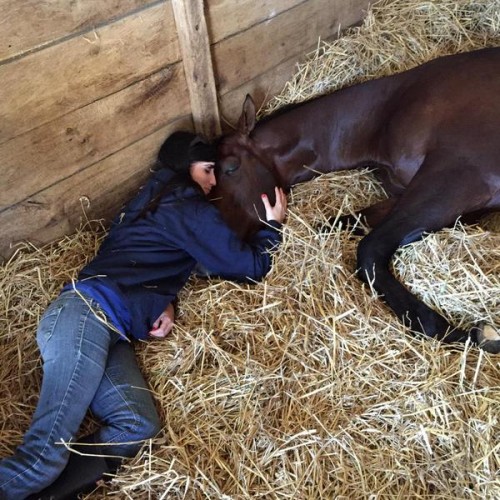
Photo courtesy of Maria Borell (@IMariaValentine)
Oh, but there’s something else lurking in Borell’s modest shedrow of five horses—a supercharged radiance of locomotion. A great ball of fire. Arguably, the country’s fastest show on dirt. Inarguably, the most appropriately named horse in training…
Runhappy.
The 3-year-old son of Kentucky Derby winner Super Saver, Runhappy has stormed to the top of sprint division with a pair of graded stakes victories in his last two starts under the care of the 32-year-old Borell. Saturday, Borell and Runhappy will be at Keeneland, just a few miles from home, where the colt will be a popular pick to win the $1,500,000 Breeders’ Cup Sprint.
JUST LOOK AT THIS SWEET BEAST FLOW!
The love between the two is evident, but how it all came together, how they each arrived here together, is nothing short of extraordinary.
“This horse is going to the Breeders’ Cup”
Runhappy and Borell found each other this past spring. He was on the mend after developing a stress fracture in his tibia early in a once promising 3-year-old season. She was a New York transplant who had moved to Kentucky just a couple of years prior with a head full of steam and a heart full of horse.
Just as the bright-eyed dreams of 20-somethings are hastily chewed up and spit out in places like New York, LA and DC, Borell was finding out in Kentucky that the realities of her chosen profession were quite unforgiving. Here in the blue-blooded world of the Kentucky racing scene, Borell was a virtual unknown. There was no stately family farm sending her good prospect after good prospect. And horse owners were not clamoring to gamble their horses on an unsung outfit. Who knows what she could be doing in there! How old is she anyway? If only more horse owners were on Instagram…
In her two years as a horse trainer, Borell had exactly zero wins. 0 for 22.
So how did a winless, fledgling greenhorn with only a handful of cheap horses land a well-bred dynamo like Runhappy?
To fully comprehend this fateful connection, we must start from the beginning.
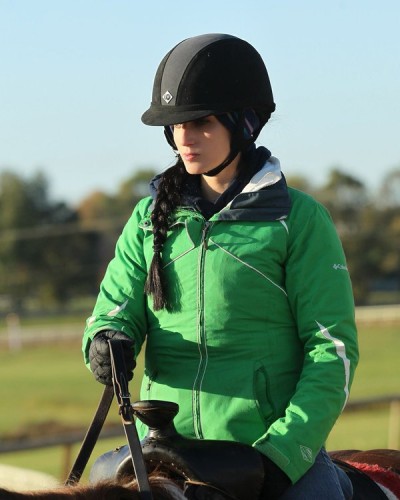
Photo courtesy of Maria Borell (@IMariaValentine)
Living the dream
The little girl was lovestruck. It was the first Saturday in May, 1989, and like millions around the world 6-year-old Maria Borell was glued to the TV for the running of the Kentucky Derby. She could not take her eyes off the dark chocolate colt with the giant white blaze they called Sunday Silence. And just like that, a horsewoman was born.
Her obsession soon evolved into the show ring and a childhood spent on hunter-jumpers. Yet, the allure of Sunday Silence and a need for speed kept her focused on galloping thoroughbreds.
“I started galloping racehorses about two years after high school,” says Borell. “I wanted to be a jockey, but I went ahead and did the college thing to make my parents happy.”
Like so many other young adults fresh out of the classroom, she was soon staring life’s inevitable question in the face: now what? Ready to roll the dice on her dreams, Borell packed up a few things and without much of a plan, left her Syracuse, NY home in the rearview and embarked into a life with horses.
It started on the backsides of Saratoga and Belmont. Galloping, mucking, doing whatever task was needed to keep her in the game. She even briefly found work as a vet tech. If she couldn’t make a career out of horses here, where else could she go?
“Then, I decided I wanted to be more hands on and make the decisions in the training,” Borell recalls. “I found that I didn’t always agree with how horses were being trained, and you don’t really have a say when you’re just the rider.”
This ‘taking things into your own hands’ is a common theme in Borell’s life. She’s not much on concessions.
So Borell shifted her focus onto a new path. If you think you can do something better, prove it. She was going to train her own racehorses. After hitting dead end after dead end in New York and growing increasingly frustrated, she decided, once more, to take another leap of faith…a new opportunity in a new place. So she left New York and headed south, to the land where thoroughbreds roam. Kentucky. As she quickly discovered however, though the pastures may have been greener, the endless maze of dead ends was oh so familiar.
With no prospects and no connection, once again, Borell grabbed the reins and began breeding her own horses. If no one will give me a chance I’ll make my own. She also started working with layups and eventually had dozens of horses under her care, but was still struggling to breakthrough.
And so it was, now two years into her grand plan, Borell was still searching for her first winner. The negative emotions that sucked her out of New York began to trickle back in. Frustration, doubt, gloom…
Still, she believed in herself and her approach to horsemanship. No, she didn’t possess the magic formula to turn slowpoke bargain breds into stakes winners, but she knew how to keep horses healthy and…happy. With a childhood spent in the show ring, she also knew how to turn out a horse. They might not be winners, but they’ll look good losing, by God. It was this attention to detail, this unshakeable love and pride for her horses, that would ultimately break her career wide open.
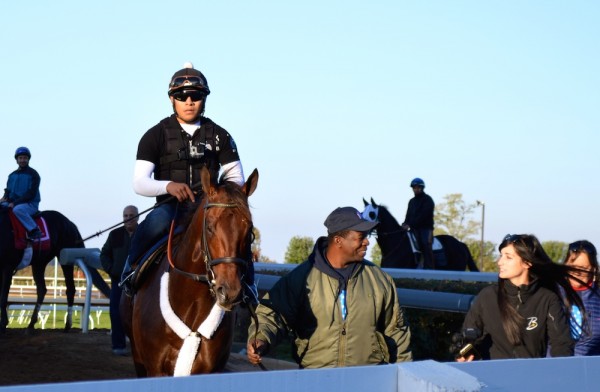
Borell (far right) and Runhappy after a workout last week.
“His owners were looking for a hands on set of eyes to get him back into training,” Borell tells me. “A friend of mine, a fellow trainer, recommended me to the owners. Our horses race against each other, and he told them, ‘She doesn’t have the best record but her horses always look the part. She works hard and her horses look great.'”
How about that? Someone had been paying attention after all.
Maria Borell did not have a stable full of stakes runners, but she had a deep love and respect for the horse, no matter how slow or incorrigible they may be. And experience be damned, she knows her way around a horse.
“I think my riding and showing experience has helped out a lot,” Borell explains. “My eye is very good for soundness. I’m very in-tuned to how they feel underneath me. I can catch little things pretty fast.”
After meeting with the racing manager for Ruhappy’s owner, Jim McIngvale, a Houston-based furniture mogul and longtime horseman, Runhappy was on his way to Borell’s barn at the Thoroughbred Training Center in Lexington.
“When he first breezed for me,” Borell recalls, “I was telling everyone, this horse is going to the Breeders Cup. He was so fast and smooth. Just effortless.”
The Breeders’ Cup? Keep in mind, Borell had never won a race. 0 for 22. My, how the tide was about to turn.
“He’s unlike any other colt I’ve been around.”
By the summer, Ruhappy was healthy and ready to roll. Borell didn’t want to give him too much to handle off his six month layoff, so she entered him into an allowance race at Indiana Downs in July for his comeback effort.
Those poor rivals. Runhappy took command from the start and never looked back, cruising to a five length win. After slogging in the muck for nearly 2 and a half years, Maria Borell finally had her picture taken. After another easy allowance score at Ellis Park, Borell was ready to see what the big colt could do. For his next act, Runhappy would take on the county’s top sprinters in the $500,000 Grade I Kings Bishop Stakes at Saratoga.
The nerve! Who does this girl think she is putting her horse in a Grade I at historic Saratoga off a $30,000 allowance win at Ellis Park?
Then the gate opened, and Runhappy did his thing.
If there’s a plaque somewhere for trainers who scored their third career win in a Grade I, Maria Borell might very well be the only name on it.
One month later, Runhappy was back in the starting gate, this time back home at Keeneland for the Grade III Phoenix Stakes. One last tune-up before Borell’s Breeders’ Cup premonition became reality.
However, when the gates opened this time Runhappy and veteran jockey Edgar Prado found themselves in a world of trouble. Breaking from the rail he was caught flat footed then soundly bumped for good measure. On top of all that, his saddle had slipped, which even for great horses is typically a recipe for throwing in the towel. Instead, Runhappy threw it in to overdrive and by the quarter pole, had taken command. By the top of the stretch he was two lengths clear of the field. And that was that.
“Freakish” is the word that comes to mind.
On to the Cup
Remember those “ideas” for better training Borell had cataloged in her mind all those years slogging away on the backstretch?
“All my horses are allowed to be horses, every day.” Borell explains. “They are turned out during the day and if something seems wrong, I don’t stop until we figure out what it is.”

Turnt up at turn out. Photo courtesy of Maria Borell (IG: kerriada)
In addition to frequent turn out and beautification, Borell uses fitness monitoring technology to track everything from heart-rate to velocity and stride.
“I love to take them swimming,” she beams. “It’s great exercise, it’s safe and they really seem to like it.”
It’s also worth noting Runhappy will be only one of a handful of horses at the Breeders’ Cup without Lasix in his system. This v8 turbo engine is fueled by hay, oats and Kentucky bluegrass. Lasix, or ferosumide, is the hottest topic of debate in racing today. It’s one of the few medications horsemen are still permitted to use due to its benefits as a diuretic to control the exercise-induced pulmonary bleeding that occurs naturally in thoroughbreds. Not all racehorses are prone to serious bleeding however, which raises the question of why the majority of horsemen use it on their horses.
For Borell, it’s as simple as this: why would she inject something into a horse she wouldn’t inject into herself?
“I hope we really do phase [Lasix] out some day,” Borell says. “I truly believe it’s better for the thoroughbred sport to not have it. Think about how weak our horses are getting. They used to have 30 race careers, not just race for one year. We need to start breeding better horses.”
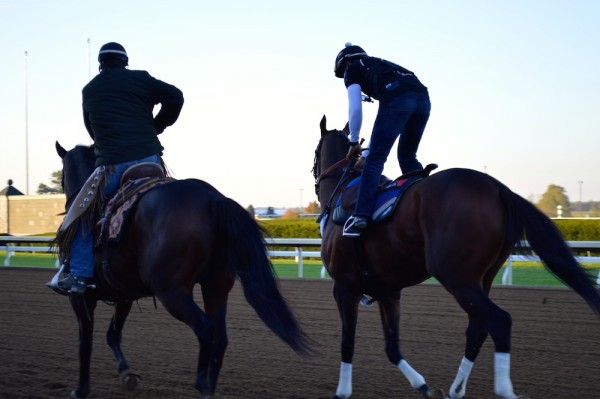
The world could use more horses like Runhappy and more trainers like Maria Borell.
“He’s unlike any other colt I’ve been around,” she says. “He’s so sweet and personable.”
Clearly.
He’s also very, very fast.
“He’s trained better into this race than he did into the Phoenix and Kings bishop,” Borell says. “He’s so much more fit now than he was this summer.”
When Runhappy loads into the gate at Keeneland this Saturday, Borell admits she’ll be nervous. Another bad break would likely doom his chances against this group of older, elite sprinters. Yet, Win or lose, Borell is just happy to be here…no, not here on her sport’s biggest stage running for seven figures, but here, in Kentucky, getting up before dawn every morning to spend time with her horses.
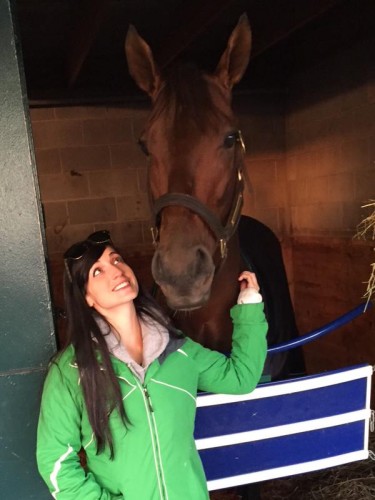
Photo courtesy of Maria Borell (@IMariaValentine)
Win or lose, Borell will be back at it Sunday morning nuzzling up with her dude (whenever he wakes up). And that’s all that matters to this horse girl.
Run on, Runhappy.




 October 29, 2015
October 29, 2015 






















